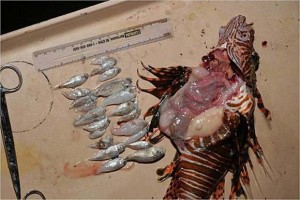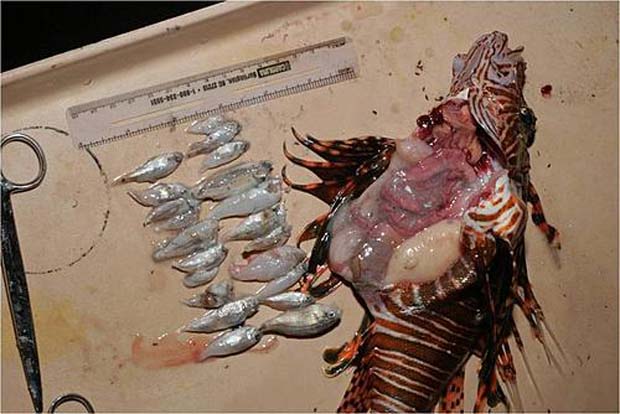Gastronomy is no silver bullet for controlling invasive species. Is it fruitless or just a bad idea ?
September, 2014
[dropcap]It[/dropcap] seems like whenever an edible animal becomes an invasive pest, someone suggests that getting people to eat it will solve the problem. For instance, in 1998 the state of Louisiana induced famous New Orleans chefs to develop recipes for nutria, which are eating away the state’s coastline. Even highly visible invasive plants inspire dreams of a gastronomic solution — there are at least four kudzu cookbooks. These schemes have never worked: Nutria continue to gnaw away at Louisiana (and Maryland and Delaware), and kudzu occupies 7.5 million acres in the U.S. and is spreading by some 125,000 acres annually.

Lionfish consume up to two fish an hour, females lay 2,000,000 eggs per spawn and spawn all year long. They can devastate a reef in a few months. They have no natural enemy. Their meat is white, firm and has excellent flavor.
One could argue that nutria and kudzu simply don’t tickle the human palate. However, even if the public could be convinced that an invasive species is a delicacy, a gastronomic approach to management is problematic for four big reasons.
First, it might not work. For dining on an invader to lower its population size, mortality must exceed the birth rate. Often mortality from harvest is simply what wildlife biologists call “compensatory” — it removes individuals that would have died anyway by old age or other means. Even if harvest mortality is not just compensatory, it must impose a huge, consistent toll on reproductive individuals to overcome reproduction, and a characteristic feature of invasive species is a very high reproductive rate.
Second, creation of a market for an invasive species provides an incentive to maintain the species in order to sustain the market, or even to spread the invader in order to improve profits. Illegally introducing fish in order to create a sport fishery is common practice and suggests the sort of spread that marketing an invasive for food can produce.
Third, if a nonnative species becomes an integral part of regional cuisine, it may become a revered cultural icon. Introduced wild boar are ecologically disastrous to the Hawaiian Islands, eating and rooting up endangered plants, causing massive erosion, and producing breeding pools for nonnative mosquitoes that carry malaria and pox that threaten the existence of several native bird species. Yet attempts to eradicate or even control populations of wild boar engender heated, heartfelt opposition from Hawaiians who have feasted on them for generations and view them as a valued part of their culture.
Fourth, U.S. law prohibits widespread transportation and marketing of most invasive species. Conservation laws forbid buying, selling, possessing or transporting any federally designated invasive plant or animal. Food laws forbid selling meat that is not properly inspected: wild-caught nutria, for example.
There is no evidence that this market has dented lionfish populations, but popular media reports about it have had the unfortunate effect of spreading the idea that a market can help control invaders.
The latest in the long line of “eat ’em to beat ’em” fads follows the 1980s introduction of Indo-Pacific lionfish to Florida. Beginning in 2005, the fish spread explosively in the western Atlantic and Caribbean. Spawning year round, females produce more than 2 million eggs per year, so the population has reached staggering densities — over 150 per acre in the Bahamas. Lionfish favor coral reefs but occupy most shallow and mid-depth marine habitats, such as seagrass meadows and mangroves, and have recently invaded estuaries. They grow quickly to well over a foot long, and they are voracious and effective predators of small fishes and crustaceans. One was observed to eat more than 20 juvenile fish in half an hour, and average consumption was about one to two fish per hour throughout the day, with effects on fish populations likely far greater than those of native predators. Not only that, but long, venomous spines render lionfish impervious to natural predation. This combination of features has allowed the fish to have catastrophic impacts on native reef fish communities, reducing resident fish populations up to 90 percent.
On the plus side, lionfish are tasty — the flesh is white, firm and mild. This has led restaurateurs to feature lionfish at premium prices. There is no evidence that this market has dented lionfish populations, but popular media reports about it have had the unfortunate effect of spreading the idea that a market can help control invaders, with virtually no discussion of efficacy or downsides. For the lionfish, in addition to the problems mentioned earlier, these include non-target impacts of the means currently used to catch them — spearfishing, which can damage reefs and harm other reef fishes.
Better approaches might come from totally different directions. Development of an attractive pheromone http://onlinelibrary.wiley.com/doi/10.1111/j.1095-8649.2007.01681.x/abstract after years of research has already contributed significantly to control of another major invasive predatory fish, the sea lamprey, in the Great Lakes. Baited traps are another possibility — but development of a technology takes research, and any trapping routine would have to avoid incidental by-catch of nontargets and also damage to reefs.
The larger message from the publicity surrounding lionfish as a menu item is this: Almost all reports trivialize the complex issue of invasions of nonnative species. By promoting an untested solution in the complete absence of evidence for its effectiveness, and promising economic benefits with no consideration of potential cost, they lead the public to believe that a quick fix will exist for any invader. The entire literature of invasion science belies this notion. The public needs information on ways to manage invasive species, not half-baked menus for the invader du jour. Stories should do justice to the complexity of the issue.
Source: ENISIA
About ENISIA
Ensia is a magazine showcasing environmental solutions in action. Powered by the Institute on the Environment, we connect people with ideas, information and inspiration they can use to change the world.



